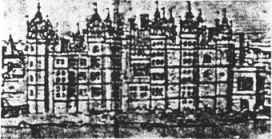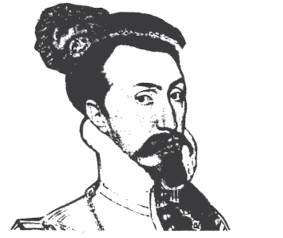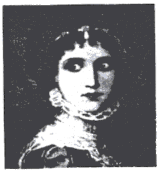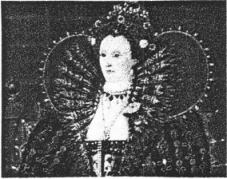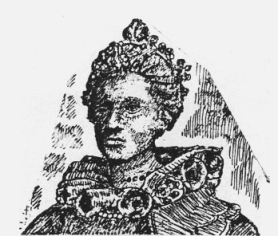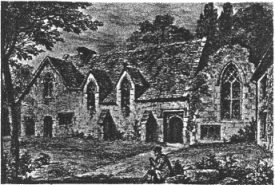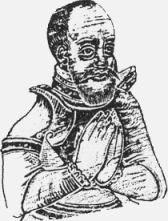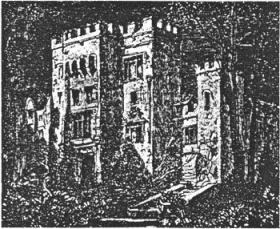
|
On June 5th, 1550, Amy Robsart married Robert Dudley at the royal palace of Sheen at Richmond, near London. Amy was about 18. It was a grand occasion, attended by the young king Edward VI.
Robert Dudley was a younger son of John Dudley, the Duke of Northumberland. In his youth Robert often met the young Princess Elizabeth. He was clever, handsome and ambitious.
Amy was the daughter of Sir John Robsart, a wealthy Norfolk landowner. Little is known of her character but it is said she was a quiet and charming young lady. No portrait of Amy has survived. This picture was produced for a postcard in the 1920s. The marriage began happily. However, Robert was ambitious and had little interest in running country estates. He was attracted by the opportunities and glamour offered by the Royal Court. He became involved in political intrigues and in 1557 took part in a foreign military expedition.
When Queen Elizabeth came to the throne in 1558, she gave Robert a position at Court as Master of the Queen's Horse. She conferred land and other honours |
upon him. Courtiers noted that
the Queen was attracted to Robert.
Nobody is sure when or for whom the statue of Queen Elizabeth in this vestry was sculpted. It had been kept in several houses in the area before the Rev. Samuel Griffith brought it here at the end of the 19th century. Robert and Amy had no children. Robert was now absent at Court for long periods. Amy lived for two years in Essex. They did not meet frequently. In 1560 Amy arrived to stay at Cumnor Place.
Cumnor Place had been built in the early 14h century by the monks of Abingdon Abbey. In 1546, following the Dissolution, Cumnor Place and the Lordship of Cumnor Manor had been granted by Henry VIII to George Owen, his physician. Owen's son and heir later leased it to Anthony Forster, a friend and servant of Robert Dudley. Amy was unhappy. There was constant gossip that her husband wished to marry Queen Elizabeth. Her maid later said she heard Amy 'pray to God to deliver her from desperation'. She might have been ill. The following letter suggests that Amy found some pleasure in buying new clothes: "edney wt my
harty comendations these shall be to desier you to take ye paynes
for me As to make this gowne of vellet whiche I sende you wt suche
A collare as you made my rosset taffyta gown you sente me
last & I will se you dyscharged for all I pray you let
it be done wt as muche speade as you can & sente by this
bearar frewen the carryar of oxforde & thus
I bed you most hartely fare well from comnare this xxiiij of avguste On 8th September 1560, a
tragic event occurred at Cumnor Place. Amy had insisted that her
servants attend Abingdon Fair, leaving her alone in the house. Later
that day she was found dead at the bottom of a flight of stairs.
Her neck was broken. |
Many of Robert's
enemies at Court and abroad claimed that he had had Amy murdered.
He was known to be a very ruthless man. These claims were never proved
but Robert's reputation was stained by the scandal. When in 1566 Lord
Cecil gave reasons to the Privy Council for the Queen not marrying
Robert, he gave as one reason 'He is infamed by delh ofhis wiff'.
In 1572 however Elizabeth created him Earl of Leicester and gave him
positions of considerable power.
The year after the tragedy, Anthony Forster bought the Lordship of Cumnor and Cumnor Place. Under the patronage of Robert he became M.P. for Abingdon. When he died in 1572 he left Cumnor Place to Robert, who soon sold it to Lord Norreys. Anthony Forster's tomb is in the chancel. A superstition concerning Amy's ghost persisted for many years. It is said that nine parsons came from Oxford to lay her restless ghost in a nearby pond, which never froze thereafter. Cumnor Place was said to be haunted. It is certainly true that the owners chose not to live there, letting it to tenants so that it gradually became a ruin.
This illustration of Cumnor Place by H.J.Ford is from 'Haunted Homes and Family Legends' by J.Ingram, published in 1897. In 1770 Julius Mickle, printer at the University Press, wrote a poem entitled 'The Ballad of Cumnor Hall', telling the sad tale of Amy. This was later read by Sir Walter Scott and it inspired him in 1820 to write a novel called 'Kenilworth'. His account of Amy's death in Cumnor was fiction and inaccurate; nevertheless the book was a best-seller and led many people to visit Cumnor. Alas, the remains of Cumnor Place had been pulled down in 1810. The cause of Amy's death remains a subject of historical speculation and research. Further Reading : D.Wilson 'Sweet
Robin' 1981.
From a display in St.Michael's, Cumnor |
